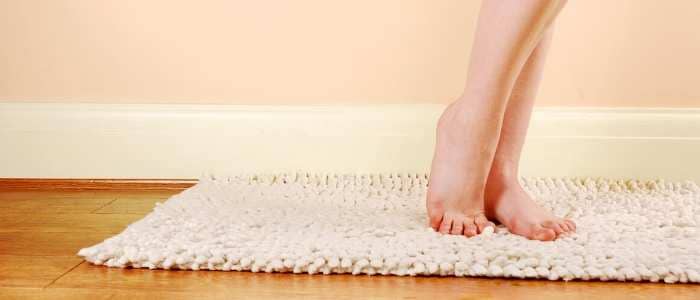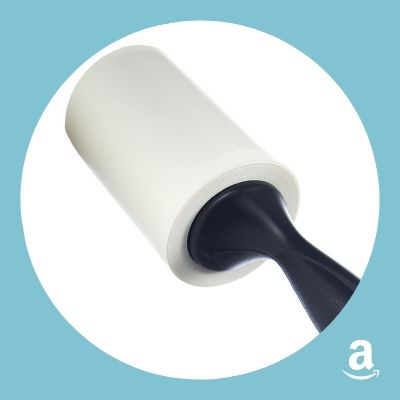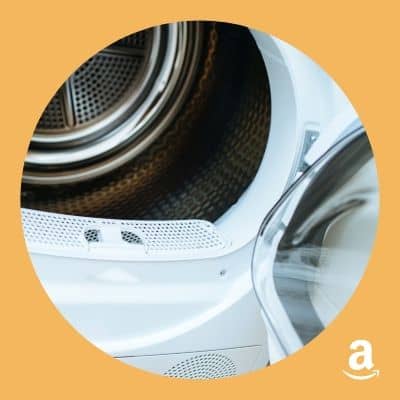When you have an overwhelming number of piles of laundry, towels, and bedsheets to wash, other things that should be cleaned regularly, such as bath mats and kitchen mats tend to get forgotten. You get busy. Then it happens, you are enjoying your alone time in the bathroom to shower, and it hits you, “What is that awful smell?!” At least that’s how it happened for me. Then I got to sniffing around. Sure enough, my bathroom rugs were the source of the stink.
My bath rugs are 100% cotton, and I bought them so they could be tossed in the washing machine. I have boys, and well, things happen to bath mats that I prefer didn’t, but here we are. I don’t own any of the fast-drying microfiber bath mats yet because of this. I need something that can handle enzyme products to break down urine and odor, can be washed a lot, and can handle strip washing from time to time.
Can You Wash Bath Mats?
Yes, you can wash bath mats either by hand or in the washing machine if your specific bath mats can tolerate the agitation of the washer. In fact, you should be washing your bath mats regularly to keep them free of mold and bacteria. Bath mats are made of different materials, so it is important to look at the care instructions of your bath mat for the best results.

How Often Should You Wash Your Bath Mats?
The short answer is that you should be washing your bathroom mats regularly. Well, how often is that? It depends. Some variables should be considered first. Let’s go over a few.
Bathroom ventilation – you may not be thinking about it, but how well-ventilated your bathroom is has a lot to do with bacteria and mold growth. Moist areas make for a wonderful breeding ground for lots of gross things. If you have a bathroom like mine that has poor ventilation, you are no stranger to mold or smell problems like mold in the bathtub, or shower, or smelly towels.
Frequency of use – if your bath mats are getting used multiple times per day, and by multiple people, then you should be washing at least once per week. If you live alone and use is minimal, then you could get away with washing less often, perhaps every other week.
Bath mat material – some bath mat materials need to be washed more often than others because of how resistant the material is to harboring mold and other bacteria. The fluffier materials, such as cotton, some polyester blends, and some memory foam mats, get wet and stay wet for much longer than some of the other bath mat materials that have been specifically designed to be fast drying. The bottom line is the longer the mat stays wet, the more of a chance for microbial growth and grossness.
Location of bath mat – bath mats can be placed all over your bathroom; in front of the sink, toilet, or outside of the shower or tub. The bath mats that stay in one area and tend to get wet or soiled often, such as in front of the toilet or bathtub, will require more frequent washing. If your bathroom mat stays in another area that doesn’t see much action, then you may not need to wash it as often.
How it dries – how your bath mat is left to dry kinda goes with the last category of location, but I think it deserves its own blurb. If you leave your bath rugs on the floor each time after you shower, there is more risk of microbial growth. This is because the material is staying damp for longer due to the lack of air-flow. Just the simple act of hanging your bath mat will decrease the chance for the growth of fungus, bacteria, and mold.
You can find fast-drying bath mats that are designed to dry quickly and also tout being bacteria and mold resistant.
Other gross factors – you might want to consider other types of contamination of the bath mat, such as urine, pets, dirt from sports or outdoor work, athlete’s foot or other fungus or infections. If any of these things are an issue, then you will need to wash much more frequently. Perhaps even multiple times a week. Not super pleasant things to think about, but necessary to keep your bath mats clean.
Wash Bath Mats in a Washing Machine
General Washing Instructions for Fabric Bath Mats
A washing machine is a convenient way to wash up your dirty bath mats. But before you toss your rugs in the washer, be sure to give the tag a looksie to see if it has specific washing instructions. You don’t want to machine wash your bath mat only to have it come out ruined. I will cover both fabric material bath mats here, but if you are looking for how to clean rubber shower mats, there will be instructions for that below.
You’ll Need
- laundry detergent
- washing machine with a gentle cycle or tub for hand washing
- clean cloth (optional for spot cleaning)
- sticky lint roller (optional if you have human and pet hair stuck to your mat as I do)
- drying space where the mat can be draped over like a shower rod
- clothes dryer (optional if your mat can go in the dryer)
Step 1: Look at the tag
Take a peek at the care instructions tag. The manufacturer will let you know if the bath mat is machine washable, the temperature to wash, if it can be washed with other items, what chemicals to use or not use, and usually how to dry it.
Step 2: Prepare for washing
Take your bath mats outdoors and shake them out. If you have long hair that gets everywhere and sticks to everything *waves hands obnoxiously in the air* or pet hair on your bath mat, take a sticky lint roller to it. You could even use a hand vac to vacuum your bath rug if you feel like shaking it out didn’t do enough. Remove as much of the loose debris as possible before washing.
If you have any stains, spot treat with a bit of detergent on a damp cloth.
Step 3: Odors or dinginess in your bath mats?
This may be an optional step for you, but if you have unpleasant smells in your bath mats, you will want to tackle the source of the odor problem first.
If you have 100% cotton bath mats as I do, you can do a pre-soak in an odor-eliminating enzyme product such as BioKleen Bac-Out. I’ve loved using Bac-Out for all sorts of things in my home since I learned about it in my cloth diapering years. I use it for urine odors for the bath mats that reside in my boys’ bathroom by soaking them for 1-2 hours.
If your odor is from mold or mildew, you can do a borax soak for 1-2 hours. The alkalinity of borax is effective in killing mold and mildew, is naturally occurring, and generally safe to use.
Just remember to do spot checks on your material to ensure that what you plan to use won’t damage it.
If your white bath mats are a bit dingy, you could do a soak with some OxiClean to brighten them back up.
Step 4: Clean the rubber backing
Most bath mats are anti-slip and have some type of rubber backing. Simply turn the bath mat over, and use a damp cloth to wipe down the backing. If your rubber backing needs a little more TLC, you could use a bit of detergent on your cloth to clean it up.
Step 5: Load the washer and add detergent
Place the bath mats inside the washing machine, add a small amount of laundry detergent, set water temperature to cold, and set to a gentle or delicate cycle. Do not use any other chemicals such as bleach or fabric softener. Also, if your bath mat is a thicker material, you will need to use less detergent.
Note: You may need to add something else to the load to keep it balanced depending on your machine and if the care instructions indicate that it is safe to wash the bath mats with other items. I keep a small stash of “scrubbing” towels in my laundry room for this use. I keep them separate from our daily bath towels.
Top-loading washing machines with center agitators may be harder on the bath mat than in a front-loading washer where they can move more freely in the drum. This is just something you want to consider when deciding to machine wash your bath mats or wash them by hand.
Step 6: Dry the bath mat
Some bath mats can be dried in the dryer on a low heat setting. Be careful with the rubber backing if you decide to dry your mats in the clothes dryer. If the temperature is too high, the heat will damage, or melt the backing, and could also potentially damage your dryer if the rubber melts onto the drum. I usually always play it safe no matter what the tag says and allow my bath mats to air dry.
Hand Washing Bath Mats
Step 1: Fill your washing tub
Fill your bathtub or large washing tub with cool water.
Step 2: Add a small amount of laundry detergent
Add enough of your laundry detergent to make some suds and mix it around the tub in a swishing motion to disperse the soap throughout the water.
Note: If you need to do a pre-soak, you could do it at this step and then drain the water and run fresh water for cleaning.
Step 3: Put your bath mats into the tub of soapy water
Submerge your bath mats and begin agitating them around in the water for a few minutes. You can take your cloth and scrub any spots you see at this time as well.
Step 4: Rinse and remove excess water from the bath mats
Drain the washing water and thoroughly rinse your bath mats, ensuring that no soap remains. You may want to fill your tub again with clean water or use the shower sprayer to help you out.
Wringing out the bath mat may not be the best idea depending on the type of material you are working with. To be safe, carefully squeeze the mats to remove excess water. Squeeze out as much water as you can before hanging the bath mats to dry.
Step 5: Hang your bath mats to air dry
Air-dry your bath mats by draping them over something like a shower rod or drying rack. Don’t use any clothespins. Doing so may damage the mat. You can also hang them outdoors if the weather is nice.
Cotton Bath Mats
Cotton is absorbent and soft and a great low-maintenance choice for bath mats. They can have non-slip rubber backing or none at all. My bath mats are all cotton and do not have rubber backings since I have to wash my mats so often. I air-dry my cotton bath mats because of the risk of the heat of the dryer shrinking them.
Memory Foam Bath Mats
Memory foam can be a tricky thing to wash in any product, and a bath mat is no different. Although some manufacturers say that it is safe to machine wash their memory foam bath mats on a gentle cycle, the customer reviews say something much different. Many reviewers claimed that the stitching came apart in the wash, or the foam got lumpy.
I don’t currently have memory foam bath mats in my home, but I have looked into them several times. If I did have them, I would opt to handwash and air-dry only.
I would tub wash using the handwashing instructions above and keep the foam flat as it submerged into the water. I would then take a cloth and gently scrub the mat without folding or bending it. Then give it a good rinse with the shower or under the faucet. To remove excess water, squeegee the mat against the side of the tub to press out as much water as you can, then lay it flat in a well-ventilated area until dry. Ideally, you would want air circulating underneath the bath mat as well as it dries. A drying rack is good for this.
Don’t use bleach, chemicals, or heat on memory foam bath mats.
Chenille and Microfiber Bath Mats
Microfiber and chenille bath mats are made of synthetic fibers such as polyester, nylon, or blends of both. They offer a luxurious feel underfoot, and also usually have good water-absorbing capabilities. Chenille microfiber has a higher pile and is shag-like, whereas microfiber mats have a smoother texture.

As always, check the tag for care instructions before attempting to wash microfiber bath mats. Many can be machine washed for convenience but don’t assume that all can. Some have a latex non-slip backing that is safe to be machine washed but use your discretion. All rubber backed mats should be air-dried.
I have a couple of cheap chenille bath rugs that I use for dog mats, so they must be washed often. However, it is a little more tedious since the care instructions for these bath mats say to hand wash only. I’m really glad I checked the tag and didn’t assume because, according to all of the research for this article, I found that most microfiber and chenille bath mats could be machine washed. I mean, those mats look identical to mine, so I’m not sure why mine is hand wash only, but I will trust the tag.
Wooden or Bamboo Bath Mats
Many people swear by wooden bath mats and say that they will never go back to using fabric ones. The wooden mat adds a modern aesthetic look to your bathroom while being extremely functional. Teak bath mats are a popular choice because they are naturally water-resistant, but tend to be a bit on the pricier side. There are also DIY options for making your own gorgeous cedar bath mat. They are easy to take care of and last for a long time if they are properly maintained.

If you have a wooden bath mat made of teak, cedar, or bamboo, it is likely that it came with cleaning instructions. There are special cleaning kits and oils for teak.
In general, for regular upkeep, most wooden bath mats can be cleaned by using a sponge with dish soap and water.
Bamboo is naturally resistant to microbial growth and super easy to wipe down using dish soap, water, and a sponge. Or you could opt to use vinegar in the place of dish soap. Either way, cleaning bamboo bath mats is a breeze.
How to Clean Shower Mats
Shower mats are different than bath mats since they typically reside inside the shower to provide a non-slip shower experience. These shower mats adhere to the bottom of the bathtub by suction cups. The issue with most vinyl, plastic, or rubber shower mats living inside your bathtub is that they become a highly susceptible area for mold growth. But how do you clean
shower mats?
First, you need to do your best to prevent mold growth in the first place. Not many think about doing so, but you need to be taking up your shower mat after each and every use and hang it to dry between uses. Leaving it at the bottom of the tub is just asking for trouble. Even forgetting about it overnight can build up some yucky grossness (that’s a technical term by the way) that will need to be cleaned up right away.
If you do have mold on your shower mat, you can use a bit of bleach in some bath water and soak it. Then use a scrub brush to wash the mat, rinse, and hang to dry.
For regular maintenance, many shower mats on the market are safe to throw into the washing machine. Toss in some other towels with it to help scrub it. I personally opt to use non-bath towels for this kind of job because it grosses me out a little to think about cleaning a moldy item with a towel that we use on our bodies. But you do you and do what you are comfortable with. You can also add a bit of bleach in the wash to take care of any mold or bacteria residing on the shower mat.
I did find that some people use the dishwasher to clean their rubber shower mats. I’m not entirely sure how I feel about doing that, but if you are comfortable with it, go for it.
If your shower mat has mold that will not come off, then it’s time to replace it and buy a new one.

Say Farewell to Stinky Bath Mats
Now you know everything you could possibly want to know about how to wash bath mats. You’re welcome. The process is fairly straightforward and doesn’t take a ton of time or work. Regular upkeep and preventing mildew, mold, bacteria, and nasty smells will keep your bath mats fresh, and they will last much longer. Remember to hang wet bath mats so they can completely dry and make washing them a part of your normal bathroom cleaning routine.
What is your favorite kind of bath mat? Let us know in the comments below. We’d love to hear from you!






Leave a Reply